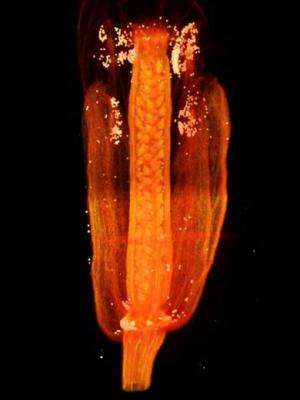Flower development in 3D: Timing is the key

In close collaboration with Jürg Schönenberger and Yannick Städler from the Department of Botany and Biodiversity Research of the Faculty of Life Sciences, University of Vienna, 14 developmental stages of the flower of Arabidopsis thaliana from very early meristematic floral initiation to fully developed seeds were monitored with micro-computed tomography in 3D. From the same set of developmental stages a full metabolic profile using mass spectrometry was measured covering hundreds of biochemical pathways.
"Smallest changes in floral organ development were thus correlated with distinct metabolic profiles, and remarkable differences in metabolism were detected over the full development", says Wolfram Weckwerth. Based on these data it is possible to define the interaction of developmental processes and metabolism in a hitherto unreached resolution. Thus, the integration of 3D data of developmental processes with metabolic activities opens up a new avenue of research in developmental biology.
Development, Sex and Metabolism
Flower development finds its fulfillment in the fusion of egg cell (ovule) and spermium. The ovule is immovable and safely protected inside the ovary whereas the spermium is mobile and transported via pollen to the female sexual organ. During fertilization the sperm cell makes its way through the elongated pollen tube towards the ovule deep inside the flower. After successful fusion a tiny embryo develops – which can be found in every plant seed.

Whether fertilization is successful relies on the correct timing of the metabolism. It is metabolism that provides all the energy and biomass resources for the developmental processes. Throughout these processes the metabolic activities of the various developmental stages undergo dramatic changes:
In the beginning a high activity of disaccharides and amino acid metabolism can be observed whereas in later stages when the sexual organs become mature monosaccharides, organic acids and different amino acids accumulate. The mature seed, finally, shows a complete different metabolic profile compared to the former ones. "There are specific metabolic signatures which represent the distinct developmental processes of all organs from early flower until fully developed fruit and seed", describes Anke Bellaire, first author of the study.
Future studies will analyze the flower development in other angiosperms lineages to reveal each specific ontogenetic signature / trajectory of the combined metabolic and morphometric profile. Based on these detailed observations generic principles of the interaction of metabolism and development will be identified.
More information: Metabolism and development – integration of micro computed tomography data and metabolite profiling reveals metabolic reprogramming from floral initiation to silique development, New Phytologist (2014) 202: 322. DOI: 10.1111/nph.12631
Journal information: New Phytologist
Provided by University of Vienna

















